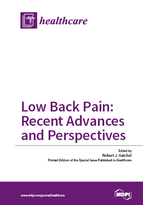Low Back Pain: Recent Advances And Perspectives
A special issue of Healthcare (ISSN 2227-9032).
Deadline for manuscript submissions: closed (28 February 2016) | Viewed by 151110
Special Issue Editor
Interests: pain management; biopsychosocial research; clinical health psychology
Special Issues, Collections and Topics in MDPI journals
Special Issue Information
Dear Colleagues,
The prevalence of chronic pain is greater than the total number of individuals in the U.S. with diabetes, heart disease, and cancer combined. Musculoskeletal pain is the most common single type of chronic pain; chronic low back pain is the most prevalent in this category, and is one of the major health problems in the U.S. With these statistics in mind, a Special Issue of Healthcare is warranted in order to update many of the recent advances and perspectives of this health problem. A number of topics will be covered: prevalence and epidemiological data; the biopsychosocial perspective of pain, which is now the most heuristic model embrace by clinical researchers; assessment and treatment approaches; and important psychosocial mediators/moderators, such as coping skills, fear avoidance, etc.
Prof. Dr. Robert J. Gatchel
Guest Editor
Manuscript Submission Information
Manuscripts should be submitted online at www.mdpi.com by registering and logging in to this website. Once you are registered, click here to go to the submission form. Manuscripts can be submitted until the deadline. All submissions that pass pre-check are peer-reviewed. Accepted papers will be published continuously in the journal (as soon as accepted) and will be listed together on the special issue website. Research articles, review articles as well as short communications are invited. For planned papers, a title and short abstract (about 100 words) can be sent to the Editorial Office for announcement on this website.
Submitted manuscripts should not have been published previously, nor be under consideration for publication elsewhere (except conference proceedings papers). All manuscripts are thoroughly refereed through a single-blind peer-review process. A guide for authors and other relevant information for submission of manuscripts is available on the Instructions for Authors page. Healthcare is an international peer-reviewed open access semimonthly journal published by MDPI.
Please visit the Instructions for Authors page before submitting a manuscript. The Article Processing Charge (APC) for publication in this open access journal is 2700 CHF (Swiss Francs). Submitted papers should be well formatted and use good English. Authors may use MDPI's English editing service prior to publication or during author revisions.
Keywords
- low back pain
- prevalence
- biopsychosocial model
- psychosocial mediators/moderators







